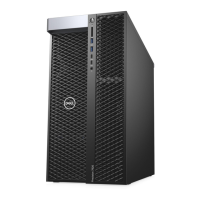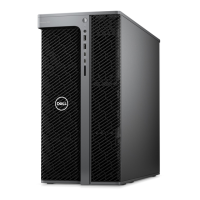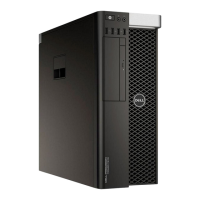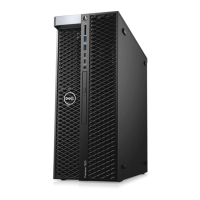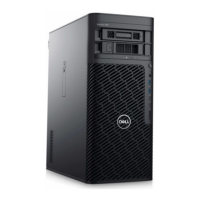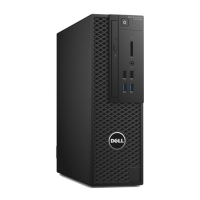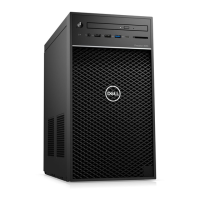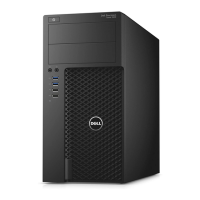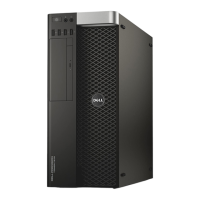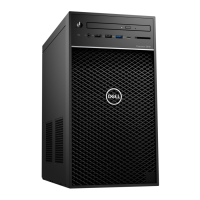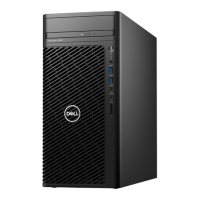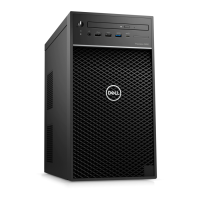Do you have a question about the Dell Precision Tower 7910 and is the answer not in the manual?
Provides safety guidelines for working inside the computer.
Steps to properly shut down the operating system.
Steps to reconnect devices and turn on the computer after maintenance.
Lists the tools required for component removal and installation procedures.
Provides a visual overview of the computer's front, back, and internal views with labeled components.
Detailed instructions for safely removing the Power Supply Unit.
Step-by-step guide for installing the Power Supply Unit into its compartment.
Procedure to detach the computer's front cover for internal access.
Steps to correctly reattach the computer's front cover.
Detailed steps to remove a hard drive from its bracket and bay.
Procedure for installing a hard drive into its caddy and securing it.
Instructions on how to detach the left side computer cover.
Steps to properly secure the left side computer cover.
Procedure to detach the chassis intrusion switch for maintenance.
Steps to install the chassis intrusion switch and connect its cable.
Instructions to remove a Peripheral Component Interconnect (PCI) card from its slot.
Steps to install a PCI expansion card into its designated slot.
Procedure to disconnect and remove a slimline optical drive.
Steps to install a slimline optical drive into the computer's bay.
Instructions to detach the memory shroud assembly from the chassis.
Steps to install the memory shroud assembly onto the computer chassis.
Procedure to remove memory modules (DIMMs) from their sockets.
Steps to insert and secure memory modules into the memory sockets.
Instructions to detach the coin-cell battery from the system board.
Steps to install a coin-cell battery into the system board slot.
Procedure to disconnect the heatsink fan and remove the heatsink assembly.
Steps to install the heatsink onto the system board and secure it.
Instructions to detach the heatsink fan from its assembly.
Steps to install the heatsink fan into its assembly.
Procedure to remove the PCIe card retention mechanism.
Steps to install the PCIe card retention mechanism.
Instructions to detach and remove the system fan assembly.
Steps to install the system fan assembly and connect its cables.
Instructions to disconnect cables and remove the I/O panel assembly.
Steps to install the I/O panel assembly and connect its cables.
Procedure to disconnect the power switch cable and remove the power switch module.
Steps to install the power switch module and connect its cable.
Instructions to disconnect the speaker cable and remove the speaker unit.
Steps to install the speaker unit and connect its cable to the system board.
Instructions to detach and remove the right side computer cover.
Steps to correctly attach and secure the right side computer cover.
Procedure to disconnect cables and remove the 5.25-inch optical drive.
Steps to install a 5.25-inch optical drive into its bay.
Instructions to disconnect and remove the Hard Drive thermal sensor.
Steps to install the HDD thermal sensor and connect its cable.
Detailed procedure to remove the processor from its socket, including safety precautions.
Steps to install a processor into its socket and secure it.
Instructions to disconnect and remove the hard-drive fan.
Steps to install the hard-drive fan and route its cable.
Procedure to disconnect cables and remove the PSU card.
Steps to install the PSU card and connect its cables.
Detailed steps to remove various components before detaching the system board.
Steps to align, secure, and connect the system board to the chassis.
Identifies and labels the various components on the system board.
Guidelines for configuring system memory for optimal performance and compatibility.
Explains how to use the front panel chassis lock mechanism for security.
Describes the PSU lock mechanism that prevents PSU removal from the chassis.
Overview of System Setup capabilities for managing hardware and BIOS options.
How to bypass setup-defined order and boot from specific devices.
Lists the keys used for navigating and interacting with System Setup options.
Details various configuration options available within the System Setup utility.
Step-by-step instructions for updating the system's BIOS firmware.
Information on creating, managing, and securing the computer with passwords.
Instructions to modify or remove existing system and setup passwords.
Procedure to disable system passwords using the PSWD jumper on the system board.
How to run the ePSA diagnostic tool for comprehensive hardware checks.
Explains the POST diagnostic LED patterns and their meanings for troubleshooting.
Lists critical error messages that stop computer operation and require a power cycle.
Lists error messages that display warnings but allow the system to continue booting.
Lists error messages that cause a soft halt, prompting user interaction to proceed.
Details specifications for the computer's processor type, core count, and cache.
Details specifications for the system's chipset and BIOS chip.
Details specifications for memory module connectors, capacity, type, and speed.
Details specifications for discrete video card slots and compatibility.
Details specifications for the integrated audio codec.
Details specifications for the integrated network controllers.
Details specifications for various expansion interfaces like PCI, Storage, and USB.
Lists and specifies external audio, network, serial, USB, and video connectors.
Lists and specifies internal power, fan, and memory connectors.
Explains the function of control buttons and indicator lights on the computer.
Details the physical dimensions and weight of the computer.
Details environmental operating specifications like temperature, humidity, and vibration.
Provides instructions on how to contact Dell for technical support, sales, or service.
Provides safety guidelines for working inside the computer.
Steps to properly shut down the operating system.
Steps to reconnect devices and turn on the computer after maintenance.
Lists the tools required for component removal and installation procedures.
Provides a visual overview of the computer's front, back, and internal views with labeled components.
Detailed instructions for safely removing the Power Supply Unit.
Step-by-step guide for installing the Power Supply Unit into its compartment.
Procedure to detach the computer's front cover for internal access.
Steps to correctly reattach the computer's front cover.
Detailed steps to remove a hard drive from its bracket and bay.
Procedure for installing a hard drive into its caddy and securing it.
Instructions on how to detach the left side computer cover.
Steps to properly secure the left side computer cover.
Procedure to detach the chassis intrusion switch for maintenance.
Steps to install the chassis intrusion switch and connect its cable.
Instructions to remove a Peripheral Component Interconnect (PCI) card from its slot.
Steps to install a PCI expansion card into its designated slot.
Procedure to disconnect and remove a slimline optical drive.
Steps to install a slimline optical drive into the computer's bay.
Instructions to detach the memory shroud assembly from the chassis.
Steps to install the memory shroud assembly onto the computer chassis.
Procedure to remove memory modules (DIMMs) from their sockets.
Steps to insert and secure memory modules into the memory sockets.
Instructions to detach the coin-cell battery from the system board.
Steps to install a coin-cell battery into the system board slot.
Procedure to disconnect the heatsink fan and remove the heatsink assembly.
Steps to install the heatsink onto the system board and secure it.
Instructions to detach the heatsink fan from its assembly.
Steps to install the heatsink fan into its assembly.
Procedure to remove the PCIe card retention mechanism.
Steps to install the PCIe card retention mechanism.
Instructions to detach and remove the system fan assembly.
Steps to install the system fan assembly and connect its cables.
Instructions to disconnect cables and remove the I/O panel assembly.
Steps to install the I/O panel assembly and connect its cables.
Procedure to disconnect the power switch cable and remove the power switch module.
Steps to install the power switch module and connect its cable.
Instructions to disconnect the speaker cable and remove the speaker unit.
Steps to install the speaker unit and connect its cable to the system board.
Instructions to detach and remove the right side computer cover.
Steps to correctly attach and secure the right side computer cover.
Procedure to disconnect cables and remove the 5.25-inch optical drive.
Steps to install a 5.25-inch optical drive into its bay.
Instructions to disconnect and remove the Hard Drive thermal sensor.
Steps to install the HDD thermal sensor and connect its cable.
Detailed procedure to remove the processor from its socket, including safety precautions.
Steps to install a processor into its socket and secure it.
Instructions to disconnect and remove the hard-drive fan.
Steps to install the hard-drive fan and route its cable.
Procedure to disconnect cables and remove the PSU card.
Steps to install the PSU card and connect its cables.
Detailed steps to remove various components before detaching the system board.
Steps to align, secure, and connect the system board to the chassis.
Identifies and labels the various components on the system board.
Guidelines for configuring system memory for optimal performance and compatibility.
Explains how to use the front panel chassis lock mechanism for security.
Describes the PSU lock mechanism that prevents PSU removal from the chassis.
Overview of System Setup capabilities for managing hardware and BIOS options.
How to bypass setup-defined order and boot from specific devices.
Lists the keys used for navigating and interacting with System Setup options.
Details various configuration options available within the System Setup utility.
Step-by-step instructions for updating the system's BIOS firmware.
Information on creating, managing, and securing the computer with passwords.
Instructions to modify or remove existing system and setup passwords.
Procedure to disable system passwords using the PSWD jumper on the system board.
How to run the ePSA diagnostic tool for comprehensive hardware checks.
Explains the POST diagnostic LED patterns and their meanings for troubleshooting.
Lists critical error messages that stop computer operation and require a power cycle.
Lists error messages that display warnings but allow the system to continue booting.
Lists error messages that cause a soft halt, prompting user interaction to proceed.
Details specifications for the computer's processor type, core count, and cache.
Details specifications for the system's chipset and BIOS chip.
Details specifications for memory module connectors, capacity, type, and speed.
Details specifications for discrete video card slots and compatibility.
Details specifications for the integrated audio codec.
Details specifications for the integrated network controllers.
Details specifications for various expansion interfaces like PCI, Storage, and USB.
Lists and specifies external audio, network, serial, USB, and video connectors.
Lists and specifies internal power, fan, and memory connectors.
Explains the function of control buttons and indicator lights on the computer.
Details the physical dimensions and weight of the computer.
Details environmental operating specifications like temperature, humidity, and vibration.
Provides instructions on how to contact Dell for technical support, sales, or service.
| Chipset | Intel C612 |
|---|---|
| Processor Options | Intel Xeon processor E5-2600 v4 product family with up to 22 cores per processor |
| Memory | Up to 1TB DDR4 ECC/non-ECC (16 DIMM slots) |
| Storage Options | SATA, SAS, SSD |
| Graphics Options | NVIDIA Quadro, AMD FirePro |
| Power Supply | 685W, 1300W |
| Operating System | Microsoft Windows 7 Professional, Red Hat Enterprise Linux, Ubuntu |
| Expansion Slots | 7 PCIe slots (x16, x8, x4) |
| Ports | USB 3.0, USB 2.0 |
| Networking | Integrated Intel I217 Gigabit Ethernet controller |
